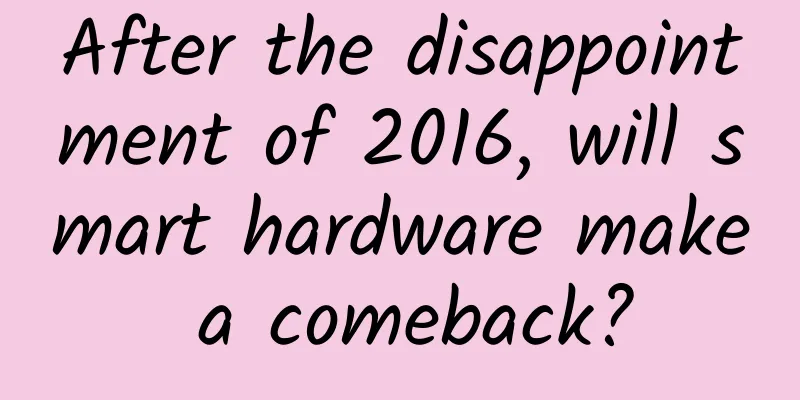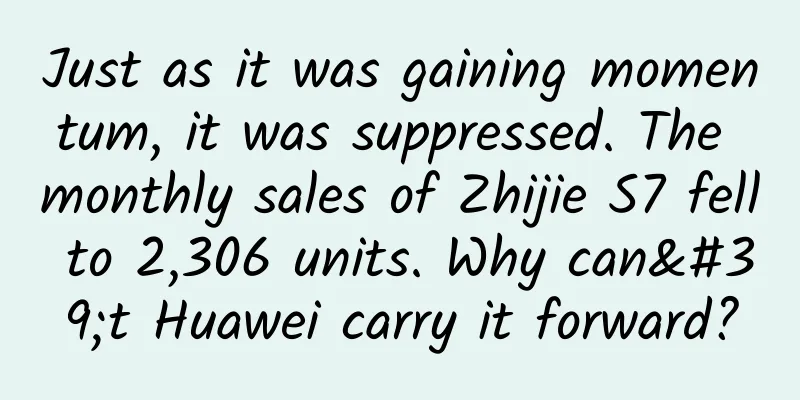After the disappointment of 2016, will smart hardware make a comeback?

|
Compared to 2015, there are not many smart hardware entrepreneurs left today. This is not because the smart hardware industry has come to an end. On the contrary, in 2016, Apple Watch was hot-selling, DJI's advantage in the drone industry remained solid, and more importantly, Xiaomi hardware continued to maintain a certain sales volume under the protection of Xiaomi, seemingly insulated from the bleak scene in the outside world. But it is no longer as exciting as when the Xiaomi bracelet was first created. This is a strange year. If you put any smart hardware industry observation in December 2015 into December 2016, there will be almost no incongruity: the ones that are still alive are still alive; the ones that are dead, perhaps no one remembers their names. If we must dwell on a change, it is that there are fewer voices of pessimism - or, in other words, not many people are willing to spend time on pessimism. "Throughout 2016, we seemed to be stuck in a vicious circle. No matter how we switched tracks, as long as we were still in the smart hardware industry, almost no one was interested," said an entrepreneur who had been involved in multiple wearable segments. Institutional dislike and lack of interest in the media have long become the norm. Apart from the roller coaster-like attention paid to VR (virtual reality), the year of smart hardware was undoubtedly lackluster. Bankruptcy, layoffs, and transformation were almost the keywords of this year. This once hot field was left in a mess. But opportunities may have been born in the midst of bleakness. Bubble burst 2015 is the golden age of smart hardware. iResearch "2015 Smart Hardware Industry Data" According to data from iResearch on the size of China's smart hardware market, the market size in 2015 increased by nearly 300% year-on-year compared to 2014. Data from JD.com also showed that the sales of JD.com's smart hardware nearly doubled in 2015, and the number of single products increased by 96% compared to 2014. However, behind these glamorous data is the chaos caused by the industry bubble that shattered rationality. In addition to wristbands, scales, speakers and other devices that are not far from the concept of intelligence, daily necessities such as tables, mirrors and sockets have also been included in the list of intelligent products by crazy practitioners. As a result, we have seen tablet computers that look like tables and mirrors, as well as "smart sockets" that are sold after adding wifi modules on various crowdfunding platforms. That year, there was a joke in the smart hardware industry: just spend an afternoon in Huaqiangbei and you can make a smart hardware by piecing together components. What's not so funny is that this joke was actually a fact that year -- practitioners could quickly get financing from VCs in this way. Hardware in this "toVC" model once occupied most of the categories in some smart hardware segments. However, this round of prosperity, which began in 2014, saw a turning point in the second half of 2015. According to relevant data, in Q3 2015, the investment in the smart hardware field experienced a sharp decline, from 4.54 billion yuan in Q2 to 570 million yuan. At the same time, according to incomplete statistics, although nearly 70 smart hardware companies in China received financing in 2014, only a handful of them received round B or above. The wait-and-see attitude of institutions started as a spark and quickly grew and spread. By the end of 2015, some manufacturers who relied on financing to maintain their expenses could no longer continue. However, people were still optimistic that this was just a short-term correction. At that time, affected by the stock market crash, RMB funds were cautious and the pace of US dollar funds was also slowing down. Many practitioners believed that as long as the funding level improved, smart hardware would return to prosperity. But obviously, this round of correction period is much longer than expected. Back to square one Funding is only one aspect. After the turning point, investors and entrepreneurs who were originally overwhelmed with anxiety calmed down and began to re-examine the rather special field of smart hardware. Compared with other hot fields, smart hardware has a longer product cycle. Take DJI Innovations as an example. Although DJI’s market share has risen rapidly since the launch of the Phantom 1 in 2012, if we count the date of its establishment in 2006, it took DJI 6 years to accumulate technology. Peng Bin, CEO of XAG, said that due to the accumulation of early technologies, DJI already has a significant advantage in the drone field; if later entrants follow the same route as DJI, it will be almost impossible for them to succeed, after all, they are already several years behind their competitors. In addition to technology, the cycle of the supply chain is still amazing. Industry insiders told Tencent Technology that the supply chain alone is enough to screen out more than 80% of the players. "A mature supply chain system often takes more than a year to build. Because it involves the distribution and game of interests of various roles in the upstream and downstream of the supply chain, this process is difficult to shorten." Not only that, a large amount of capital investment is required in each link such as ODM, OEM, and channels, and raw materials usually need to be paid in advance, which means that in the preparation stage of smart hardware, it may be necessary to invest unimaginable funds and time. But these processes were almost ignored around 2015. "The capital that poured in at the time did not really understand the industry," said a person who has helped multiple smart hardware projects complete financing. Many investors blindly bet on the track and expected to quickly produce a hit product after investing heavily, but they did not know that there was a long cycle in the hardware field and just thought that finding a foundry could solve the problem. This has resulted in the industry barriers that should have been established by product cycles and supply chains not being created as expected. In fact, in the hardware industry, technological accumulation and supply chain and channel advantages are far more important than creativity most of the time. Since then, a large number of products lacking technical content and modified from public molds have been born, and the "prosperity" of smart hardware has evolved into a kind of disorder. Moreover, these products that come and go quickly lack core competitiveness and can only “make a quick buck and leave”, and cannot produce real hits or bring about qualitative changes in the company’s value. This is reflected in the venture capital circle, where the data is ugly and no one is willing to take over. An institutional investment manager told Tencent Technology that investment institutions still pay more attention to the issue of when to exit and generate profits. After a round of investment, smart hardware has not produced sufficiently convincing results, which makes institutions more cautious. But perhaps, this kind of "caution" should be the attitude we should have when facing the hardware field. In the end, the uniqueness of the smart hardware industry still made the investment go to waste. People found that smart hardware should never follow the rules of the Internet - only by returning to the hardware category can smart hardware have opportunities. From smart hardware to hardware intelligence After returning to rationality, the threshold in the field of smart hardware has finally been taken seriously. According to TalkingData, Xiaomi, Huawei, Samsung and other manufacturers with certain technical reserves in the hardware field have already occupied the mainstream in the smart hardware field; especially in the field of smart home, their advantages are very obvious. This also means that now that mature players have already laid out their plans, if entrepreneurs want to enter the field of smart hardware, they must have a certain level of hardware "hard power"; especially in vertical segments, players with a certain amount of accumulation will likely usher in a greater period of development. On the contrary, entrepreneurs who lack accumulation will find it difficult to break through in this increasingly rational field. One example that can be used to prove this is that in 2016, when the industry was predicting a decline, Lepu Medical, which launched the Lepu wristband, bucked the trend and became the first listed smart hardware company in China. Gao Xiang, founding partner of Gaorong Capital, an investor of Lepu Medical, said that Lepu Medical had provided products to high-end health hardware brands in Europe and the United States in the early days, which was one of the reasons why Gaorong valued Lepu. In fact, the 14-year technical accumulation in medical equipment is also the foundation that Lepu Medical has relied on for a long time. In an exclusive interview with Tencent Technology, Pan Weichao, the founder of Lepu Medical, said that in the future, Lepu Medical will not deliberately cater to industry hot spots, but will adhere to industry rules and continue to invest in research and development with the idea of sitting on the bench for ten years. On the other hand, beyond the entry threshold, the positioning of smart hardware is also quietly changing. Although many investors love technology-oriented products, their final positioning of the product is definitely not limited to technology. Technology directly affects the "geek" group, and this group is also the main user group of smart hardware in the past; but a good product in the eyes of investors will target a much larger group of people, and even needs to become a mass consumer product. According to this idea, except for some high-tech products such as robots (and related artificial intelligence), more smart hardware products need to be clearly defined as consumer-grade products. They should no longer play the "high-end" card, but should be more down-to-earth. This is also the reason why more and more smart hardware is moving towards offline channels. Taking Niu electric vehicles as an example, Niu COO Li Yan told Tencent Technology that although online sales are still the mainstream, by 2017, online and offline sales are likely to be equal; by 2018, offline sales may be much higher than online sales. Offline channels have become a new arena. Whether a product can be quickly introduced to first-tier and second-tier cities and towns, or even third-tier and fourth-tier cities and towns, is increasingly being considered in the team's quality assessment. An entrepreneur in the children's watch industry told Tencent Technology that an extreme example was that previously in Shandong, a hardware team with sales channels behind it obtained a considerable amount of financing relying solely on offline sales networks. This is very different from the early days of the smart hardware industry, when investors could be convinced by just one crowdfunding channel. It can be seen that the above series of requirements make the smart hardware field no longer essentially different from traditional hardware entrepreneurship. But this is not a bad thing. Whether it is smart hardware or hardware intelligence, the product itself is ultimately required to have strong practicality, which is precisely what smart hardware lacked the most. After returning to traditional thinking, even if the smart hardware that was once full of false fire is no longer as popular as it was at the beginning, it is very likely to return to the right track. After all, in the era of the Internet of Things, intelligent hardware should not be absent. As a winner of Toutiao's Qingyun Plan and Baijiahao's Bai+ Plan, the 2019 Baidu Digital Author of the Year, the Baijiahao's Most Popular Author in the Technology Field, the 2019 Sogou Technology and Culture Author, and the 2021 Baijiahao Quarterly Influential Creator, he has won many awards, including the 2013 Sohu Best Industry Media Person, the 2015 China New Media Entrepreneurship Competition Beijing Third Place, the 2015 Guangmang Experience Award, the 2015 China New Media Entrepreneurship Competition Finals Third Place, and the 2018 Baidu Dynamic Annual Powerful Celebrity. |
<<: Uxin sues Guazi for unfair competition, battle for car sources escalates
>>: GM accused of manipulating U.S. autonomous driving legislation
Recommend
Survey shows that most developers have never built a mobile app
Although there are more and more mobile phones in...
Have you been eating CP today? Six years later, this "model couple" finally has a child again
The daily companionship of the model couple Red E...
Xiaozu Douyin store group has no source of goods and practical internal training is worth 6,800 yuan
The course comes from Douyin Store Group Business...
Short video app “Tik Tok”: Will it become popular for a while and then die?
I wrote an article before about how the rapidly g...
It’s been seven years. Do you still remember the “rabbit” that lived on the moon?
"Hi! Good night this time!" Seven years...
The Asian Cup has begun! Small footballs have made fans crazy, how can we watch the game rationally?
The much-anticipated Asian Cup has begun, and it ...
17 thoughts on marketing, copywriting, and life!
1. Please accept this marketing trick! Frederick ...
Practical Tips丨A review of the four creative points in financial management advertising
According to the industry delivery report previou...
Xiaohongshu Product Analysis
Go to Xiaohongshu to see which brand is better&qu...
Offline event planning and traffic diversion skills!
Nowadays, the Internet dividend period has long d...
What are the skills and methods for selling goods through Kuaishou live streaming? How many people does the Kuaishou live streaming sales team need?
This article mainly introduces the skills and met...
How to do viral marketing well? 3 types and 4 elements you must know
Viral marketing is a very effective way to achiev...
Tesla's frequent car accidents have not stopped car companies from developing enthusiasm for autonomous driving technology, which is expected to enter a period of explosive growth in 2020
From the new car brand Tesla to the technology gia...
How much does it cost to create a course mini app in Hangzhou?
The factors affecting the quotation of Hangzhou c...
The Ideal Car broke down after nine days and could not be returned or exchanged due to lagging regulations. How could users be allowed to swallow this bitter fruit?
On July 7, the 1818 Golden Eye program reported t...









